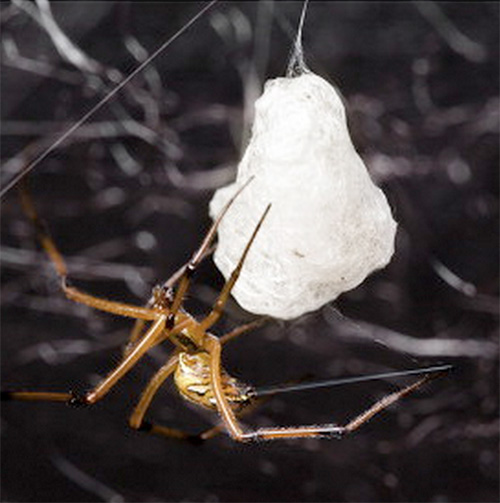How male black widows keep rivals away

Two new EEB grad-students: Devin Kirk, now in Professor Krkosek’s lab and lead author Catherine Scott who is starting a PhD in September with Maydianne Andrade show that male behavior discourages rival males.
Highlights
- We investigated the function of web reduction by courting male black widows
- We compared the attractiveness of intact and reduced female webs to males
- Male-reduced webs attracted three times fewer males than intact webs in the field
- Web reduction alters or prevents emission of silk-borne female pheromones
- Web reduction helps males monopolize females during lengthy courtship
Male adaptations that limit sperm competition include guarding females, applying mating plugs and chemically reducing the attractiveness or receptivity of females. In many web-building spider species, females attract males with silk-borne volatile pheromones. In widow spiders (Latrodectus, 30 species), the courting male often engages in web reduction behaviour during which he excises and bundles sections of the female’s web and wraps them with his own silk. Hypothesized functions of this widespread behaviour include sexual communication (e.g. through dissemination of male sex pheromone) and/or decreasing the female’s attractiveness to rivals. The latter function was previously demonstrated in a single spider species, Neriene litigiosa, but the extent to which web reduction may decrease male–male competition has never been quantified in the field. In a dense population of western black widows, Latrodectus hesperus, we ran mate attraction experiments to test the hypothesis that web reduction and/or male silk addition decrease web attractiveness to potential rivals. Webs reduced by males attracted three times fewer males than intact webs; webs with a similar proportion of silk experimentally removed attracted as many males as intact webs. However, the experimental addition of male silk did not affect the attractiveness of intact webs. We conclude that web reduction in black widows limits male–male competition by reducing the attraction of rival males to females’ webs. This effect is probably mediated through targeted excision of pheromone-laden silk by courting males, possibly in combination with the male’s silk forming a physical barrier to pheromone emission.
Citation
Web reduction by courting male black widows renders pheromone-emitting females’ webs less attractive to rival males.
Catherine Scott, Devin Kirk, Sean McCann. Animal Behavior 107: 71-78 doi:10.1016/j.anbehav.2015.06.009
See Press Coverage in
